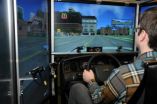(Press-News.org) HOUSTON – (March 13, 2014) –Open, feed, cut. Such is the humdrum life of a motor molecule, the subject of new research at Rice University, that eats and excretes damaged proteins and turns them into harmless peptides for disposal.
The why is obvious: Without these trash bins, the Escherichia coli bacteria they serve would die. And thanks to Rice, the how is becoming clearer.
Biophysicists at Rice used the miniscule machine – a protease called an FtsH-AAA hexameric peptidase – as a model to test calculations that combine genetic and structural data. Their goal is to solve one of the most compelling mysteries in biology: how proteins perform the regulatory mechanisms in cells upon which life depends.
The Rice team of biological physicist José Onuchic and postdoctoral researchers Biman Jana and Faruck Morcos published a new paper on the work this month for a special issue of the Royal Society of Chemistry journal, Physical Chemistry Chemical Physics.
The special issue edited by Rice biophysicist Peter Wolynes and Ruth Nussinov, a researcher at the National Cancer Institute in Frederick, Md., and a professor at the Sackler School of Medicine at Tel Aviv University, pulls together current thinking on how an explosion of data combined with ever more powerful computers is bringing about a second revolution in molecular biology.
The paper describes the Onuchic group's first successful attempt to feed data through their computational technique to describe the complex activity of a large molecular machine formed by proteins. Ultimately, understanding these machines will help researchers design drugs to treat diseases like cancer, the focus of Rice's Center for Theoretical Biological Physics.
"Structural techniques like X-ray crystallography and nuclear magnetic resonance have worked quite well to help us understand how smaller proteins function," Onuchic said. X-rays only take snapshots of constantly moving proteins, he said, "but functional proteins, big protein complexes and molecular machines have multiple conformations.
"Computational models are also useful, but to understand the full dynamics of these large proteins, where a lot of the interesting biology takes place, we have to supplement them with more information," he said.
That information comes from direct coupling analysis (DCA), a statistical tool developed by Morcos and Onuchic with colleagues at the University of California, San Diego, and the Pierre and Marie Curie University. DCA looks at the genetic roots of proteins to see how amino acids – the "beads" in the unfolded protein strands -- co-evolved to influence the way a protein folds. Each bead carries an intrinsic energy that contributes to the strand's distinct energy landscape, which dictates how it folds into its functional state.
Even after they fold, proteins are in perpetual motion, acting as catalysts for countless bodily functions. They can combine into larger molecular machines that grab other molecules, "walk" cargoes within a cell or cause muscles to contract.
One such biomachine is FtsH, a membrane-bound molecule in E. coli made of six protein copies that form two connected hexagonal rings. The molecule attracts and degrades misfolded proteins and other cellular detritus, pulling them in through one ring, which closes like the shutter of a camera and traps the proteins. They are cut apart as they exit through the other ring.
Through molecular simulations using structure-based models and the discovery via DCA of likely couplings in the genetic source of the proteins, the Rice team found evidence to support the hypothesis of a "paddling" mechanism in the molecule that Morcos described as a collapse of the two rings once trash found its way inside.
"First the ring pore closes to grab the protein; then the molecule flattens," he said. "Then when the motor is flat, the rings open to release the peptides and the molecule expands again to restart the cycle."
Key to the success of DCA is the realization that amino acid mutations represent contacts that co-evolve for specific purposes. The contact maps created by DCA can reveal previously unknown details to model transitions between functional states, like the paddling in FtsH, Onuchic said.
"We can look at the evolutionary tree of these proteins and see which pairs of amino acids changed together. We then assume these are contacts," he said. "Through DCA, Faruck uses a lot of physics to understand when two amino acids can act directly or indirectly, and separate the two. Then we predict how coupled they are, and the higher the probability, the more evidence that these are real contacts."
DCA would do little without the flood of data available since the ability to scan entire genomes became possible, and even commonplace, in recent decades. Advances in the century-old art of crystallography are making better structure-based models available as well.
"Even if the mathematical framework was ready and we had crystallographic data for this motor protein in the 1990s, there weren't enough sequences available until the 2000s," Morcos said. "Now we have all the pieces converging."
He said understanding essential motor proteins in bacteria will be important as researchers begin to apply DCA to advance human health. "For us, the most exciting part is that we're now able to tackle really big systems," Morcos said.
INFORMATION:
The research was supported by the Center for Theoretical Biological Physics, the Welch Foundation, the National Science Foundation and the Cancer Prevention and Research Institute of Texas. Onuchic is the Harry C. and Olga K. Wiess Chair of Physics and Professor of Physics and Astronomy. Wolynes is the D.R. Bullard-Welch Foundation Professor of Science and a professor of chemistry.
Read the abstract at http://pubs.rsc.org/en/content/articlelanding/2014/cp/c3cp55275f#!divAbstract
This news release can be found online at http://news.rice.edu/2014/03/13/big-data-tackles-tiny-molecular-machines/
Follow Rice News and Media Relations via Twitter @RiceUNews
Related Materials:
Center for Theoretical Biological Physics: http://ctbp.rice.edu
Images for download:
http://news.rice.edu/wp-content/uploads/2014/03/0317_PROTEIN-Graphic-web.jpg
Co-evolved mutations in genetic sequences that code proteins show researchers how a protein is likely to fold and what forms it may take as it carries out its function. Scientists at Rice University used the technique called direct coupling analysis in combination with structure-based models to find a previously hidden conformation of a molecular motor responsible for degrading misfolded proteins in bacteria. (Credit: Faruck Morcos/Rice University)
Located on a 300-acre forested campus in Houston, Rice University is consistently ranked among the nation's top 20 universities by U.S. News & World Report. Rice has highly respected schools of Architecture, Business, Continuing Studies, Engineering, Humanities, Music, Natural Sciences and Social Sciences and is home to the Baker Institute for Public Policy. With 3,920 undergraduates and 2,567 graduate students, Rice's undergraduate student-to-faculty ratio is 6.3-to-1. Its residential college system builds close-knit communities and lifelong friendships, just one reason why Rice has been ranked No. 1 for best quality of life multiple times by the Princeton Review and No. 2 for "best value" among private universities by Kiplinger's Personal Finance. To read "What they're saying about Rice," go here.
David Ruth
713-348-6327
david@rice.edu
Mike Williams
713-348-6728
mikewilliams@rice.edu
Big data tackles tiny molecular machines
Rice University technique able to analyze conformations of complex molecular machines
2014-03-14
ELSE PRESS RELEASES FROM THIS DATE:
Older adults: Build muscle and you'll live longer
2014-03-14
New UCLA research suggests that the more muscle mass older Americans have, the less likely they are to die prematurely. The findings add to the growing evidence that overall body composition — and not the widely used body mass index, or BMI — is a better predictor of all-cause mortality.
The study, published in the American Journal of Medicine, is the culmination of previous UCLA research led by Dr. Preethi Srikanthan, an assistant clinical professor in the endocrinology division at the David Geffen School of Medicine at UCLA, that found that building muscle mass is ...
New cell line should accelerate embryonic stem cell research
2014-03-14
Researchers at the University of Washington have successfully created a line of human embryonic stem cells that have the ability to develop into a far broader range of tissues than most existing cell lines.
"These cells will allow us to gain a much greater understanding of normal embryonic development and have the real potential for use in developing ways to grow new tissues and organs for transplantation," said Carol Ware, a professor in the UW Department of Comparative Medicine and lead author of a paper describing the new cell line appearing in the March 10 issue ...
Motion and muscles don't always work in lockstep, researchers find in surprising new study
2014-03-14
RIVERSIDE, Calif. — Animals "do the locomotion" every day, whether it's walking down the hall to get some coffee or darting up a tree to avoid a predator. And until now, scientists believed the inner workings of movement were pretty much the same — the nerves send a message to the muscles and there is motion.
But in a first-of-its-kind study on wild green anole lizards, biologists at the University of California, Riverside have discovered that the link between muscle function and movement is a lot more complicated than anyone realized.
"We were trying to understand ...
Critical role of one gene to our brain development
2014-03-14
Research from the University of Adelaide has confirmed that a gene linked to intellectual disability is critical to the earliest stages of the development of human brains.
Known as USP9X, the gene has been investigated by Adelaide researchers for more than a decade, but in recent years scientists have begun to understand its particular importance to brain development.
In a new paper published online in the American Journal of Human Genetics, an international research team led by the University of Adelaide's Robinson Research Institute explains how mutations in USP9X ...
Drivers with hemianopia fail to detect pedestrians
2014-03-14
BOSTON (March 14, 2014) — A diagnosis of hemianopia, or blindness in one half of the visual field in both eyes as the result of strokes, tumors or trauma often means the end of driving.
In about half of the states in the United States and in many other countries, driving with hemianopia is prohibited. However, in some countries including Belgium, the Netherlands, the UK, Switzerland and Canada, driving with hemianopia is permitted after passing a specialized road test. Researchers at Massachusetts Eye and Ear/Schepens Eye Research Institute set out to determine the extent ...
New findings show link between diabetes and pancreatic cancer
2014-03-14
In a new study published today in Annals of Surgical Oncology, clinicians worked with mathematicians to review data from 1973 to 2013 to conclude there was a time-dependent link between being diagnosed with diabetes and pancreatic cancer.
A review of 88 international studies to date, is the largest analysis on the topic published.
Dr Mehrdad Nikfarjam, liver, pancreas and biliary specialist from the Department of Surgery at the University of Melbourne said pancreatic cancer was often diagnosed when at an advanced, incurable stage.
"This is an important paper that ...
New stratigraphic research makes Little Foot the oldest complete Australopithecus
2014-03-14
After 13 years of meticulous excavation of the nearly complete skeleton of the Australopithecus fossil named Little Foot, South African and French scientists have now convincingly shown that it is probably around 3 million years old.
In a paper published today, Friday, 14 March 2014 at 12:00 (SATS), in the scientific journal, the Journal of Human Evolution, the latest findings by Professor Ron Clarke from the University of the Witwatersrand and his colleagues refute previous dating claims that suggested Little Foot is younger. (See the all authors' details and affiliations ...
New knowledge: Blood poisoning increases the risk of blood clots
2014-03-14
Every year, almost 10,000 Danes are admitted to hospital with blood poisoning, while more than 3,000 patients become infected while they are hospitalised. New research shows that Danes suffering from blood poisoning risk an extra challenge in the form of an increased risk of suffering a blood clot:
"We have followed more than 4,000 people who have been admitted with blood poisoning. The study shows that the risk of suffering a blood clot in either the brain or the heart is twice as high for patients with blood poisoning in relation to other patients who are also admitted ...
An experiment recreates the crust of the moon Europa
2014-03-14
Water, salts and gases dissolved in the huge ocean that scientists believe could exist below Europa´s icy crust can rise to the surface generating the enigmatic geological formations associated to red-tinged materials that can be seen on this Jupiter's satellite. This is confirmed by the experiment carried out in the laboratory with water, carbon dioxide and magnesium sulfate by researchers at Centro de Astrobiología (CAB, Spain).
Scientists suspect that inside Europa, one of the icy moons of Jupiter, reservoirs of liquid water exists, the essential element for life on ...
Number of days without rain to dramatically increase in some world regions
2014-03-14
By the end of the 21st century, some parts of the world can expect as many as 30 more days a year without precipitation, according to a new study by Scripps Institution of Oceanography, UC San Diego researchers.
Ongoing climate change caused by human influences will alter the nature of how rain and snow falls; areas that are prone to dry conditions will receive their precipitation in narrower windows of time. Computer model projections of future conditions analyzed by the Scripps team indicate that regions such as the Amazon, Central America, Indonesia, and all Mediterranean ...
LAST 30 PRESS RELEASES:
Tracing the quick synthesis of an industrially important catalyst
New software sheds light on cancer’s hidden genetic networks
UT Health San Antonio awarded $3 million in CPRIT grants to bolster cancer research and prevention efforts in South Texas
Third symposium spotlights global challenge of new contaminants in China’s fight against pollution
From straw to soil harmony: International team reveals how biochar supercharges carbon-smart farming
Myeloma: How AI is redrawing the map of cancer care
Manhattan E. Charurat, Ph.D., MHS invested as the Homer and Martha Gudelsky Distinguished Professor in Medicine at the University of Maryland School of Medicine
Insilico Medicine’s Pharma.AI Q4 Winter Launch Recap: Revolutionizing drug discovery with cutting-edge AI innovations, accelerating the path to pharmaceutical superintelligence
Nanoplastics have diet-dependent impacts on digestive system health
Brain neuron death occurs throughout life and increases with age, a natural human protein drug may halt neuron death in Alzheimer’s disease
SPIE and CLP announce the recipients of the 2025 Advanced Photonics Young Innovator Award
Lessons from the Caldor Fire’s Christmas Valley ‘Miracle’
Ant societies rose by trading individual protection for collective power
Research reveals how ancient viral DNA shapes early embryonic development
A molecular gatekeeper that controls protein synthesis
New ‘cloaking device’ concept to shield sensitive tech from magnetic fields
Researchers show impact of mountain building and climate change on alpine biodiversity
Study models the transition from Neanderthals to modern humans in Europe
University of Phoenix College of Doctoral Studies releases white paper on AI-driven skilling to reduce burnout and restore worker autonomy
AIs fail at the game of visual “telephone”
The levers for a sustainable food system
Potential changes in US homelessness by ending federal support for housing first programs
Vulnerability of large language models to prompt injection when providing medical advice
Researchers develop new system for high-energy-density, long-life, multi-electron transfer bromine-based flow batteries
Ending federal support for housing first programs could increase U.S. homelessness by 5% in one year, new JAMA study finds
New research uncovers molecular ‘safety switch’ shielding cancers from immune attack
Bacteria resisting viral infection can still sink carbon to ocean floor
Younger biological age may increase depression risk in older women during COVID-19
Bharat Innovates 2026 National Basecamp Showcases India’s Most Promising Deep-Tech Ventures
Here’s what determines whether your income level rises or falls
[Press-News.org] Big data tackles tiny molecular machinesRice University technique able to analyze conformations of complex molecular machines




